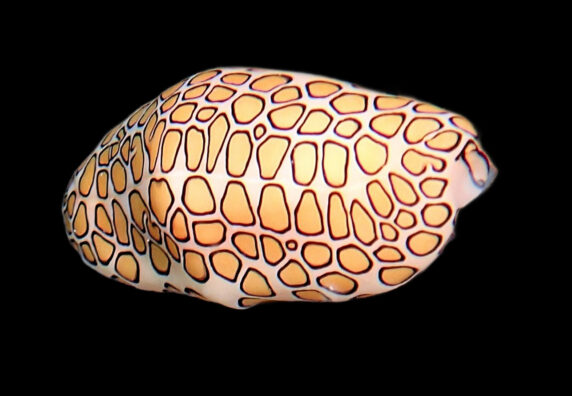Flamingo Tongue Shell, Cyphoma gibbosum
 Flamingo Tongue Shell, Cyphoma gibbosum. Live animal from coastal waters off Akumal, Quintana Roo, March 2018. Collection and photograph courtesy of Juan Rojo, Akumal.
Flamingo Tongue Shell, Cyphoma gibbosum. Live animal from coastal waters off Akumal, Quintana Roo, March 2018. Collection and photograph courtesy of Juan Rojo, Akumal.

 Flamingo Tongue Shell, Cyphoma gibbosum. Shell collected from coastal waters off Akumal, Quintana Roo, October, 1998. Collection, identification, and photograph courtesy of Bob Hillis, Ivins Utah.
Flamingo Tongue Shell, Cyphoma gibbosum. Shell collected from coastal waters off Akumal, Quintana Roo, October, 1998. Collection, identification, and photograph courtesy of Bob Hillis, Ivins Utah.
Phylogeny: The Flamingo Tongue, Cyphoma gibbosum (Linnaeus, 1758) is a gastropod mollusk from the Ovulidae Family of Cowry Allies or False Cowries. The genus Cyphoma is one of forty-four genera in this family, and there are fourteen species in this genus. They are known in Mexico as Caracol Lengua de Flamenco.
Description: The Flamingo Tongue is small in stature but can be brightly colored. The shells are thick and elongated, with a narrow aperture. The dorsum exhibits a thick transverse ridge. The exterior of the shell is smooth and shiny. The exterior of the shell is a reddish-cream to salmon to white in color, with a longitudinal white or cream-colored band. The interior is white or pinkish. The living animals are bright orange-yellow in color, with black markings. Their colors vary significant from animal to animal. The mantle is normally extended and retracted only when the snail is under attack. The shells reach a maximum of 4.4 cm (1.7 inches) in length. Juvenile shells are fragile and transparent taking the color of the host gorgonian for camouflage from predation.
Habitat and Distribution: Flamingo Tongues are usually found on sea fans and other gorgonians in coral reef environments. The only time they are not on a soft-coral, is when they are crawling from one host to another. They are normally found in colonies of two or three individuals. They are found at depths ranging from 0.3 m (1 foot) to, at least, 30 m (100 feet), with some sources extending the maximum depth to 90 m (295 feet) . They are a tropical Western Atlantic species. In Mexican waters, they are found along the entire east coast, in both Gulf of Mexico and Caribbean waters.
Ecology and Behavior: Flamingo Tongues are diurnal ectoparasites that feed on the living tissues of gorgonian soft corals. As they consume the gorgonian polyps, they incorporate the toxins, making themselves distasteful or poisonous to predators. Despite this defense mechanism they are still prey for hogfishes, pufferfishes, and spiny lobsters. Flamingo Tongues are gonochoric and reproduce sexually, with internal fertilization. The females lay their eggs within mucus nets that are attached to the host corals that they feed on. Several hundred planktonic larvae hatch within ten days and eventually settle out in other soft gorgonian corals. The juveniles will hide on the underside of the corals while the adults are highly visible and mobile. There is no mention in the available literature of Flamingo Tongues engaging in any types of parasitic, commensal, or symbiotic relationships. Amateur conchologist collect these animals due their color later to discover that the observed color is from the mantle tissue of the snail which covers the shell and not from its shell. The Flamingo Tongue Snail has not formally evaluated from a conservation perspective but in heavily visited areas snorkelers and scuba divers over-collect the live animals due to their beauty and their populations have been severely depleted.
Synonyms: Bulla gibbosa, Cyphoma alleneae, Cyphoma dorsatum, Cyphoma finkli, Cyphoma gibbosa, Cyphoma lindae, Cyphoma precursor, Ovula pharetra, Ovula rostrata, and Ultimus precursor.